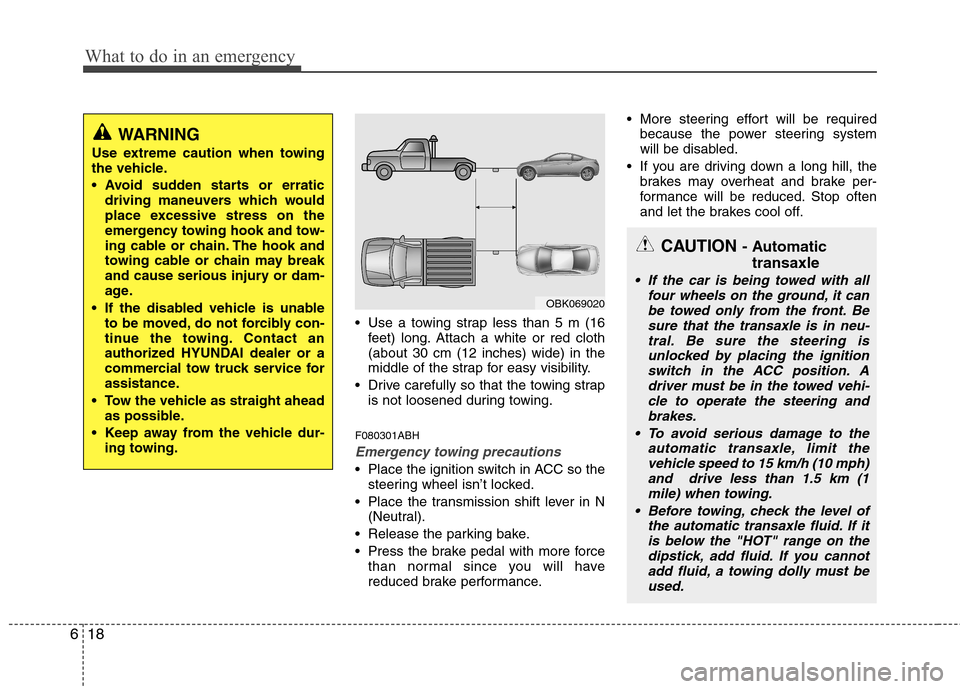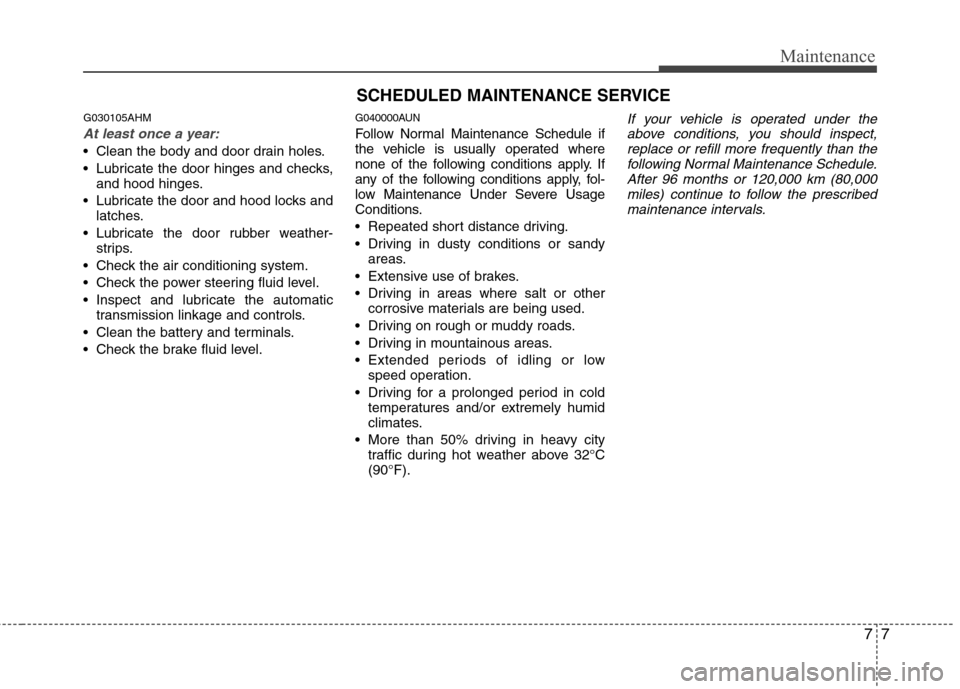Page 16 of 322
Your vehicle at a glance
4
2
ENGINE COMPARTMENT
1. Negative battery terminal..................7-31
2. Positive battery terminal ...................7-31
3. Fuse and relay box ...........................7-44
4. Windshield washer fluid reservoir .....7-23
5. Power steering fluid reservoir ...........7-22
6. Air cleaner.........................................7-25
7. Radiator cap .....................................7-20
8. Engine oil filler cap ...........................7-17
9. Engine oil dipstick .............................7-17
10. Brake fluid reservoir ........................7-21
11. Engine coolant reservoir .................7-19
OBK019003
B030000ABH-EE■
■
2.0 TCI Engine
* The actual engine room in the vehicle may differ from the i llustration.
Page 17 of 322
25
Your vehicle at a glance
1. Negative battery terminal..................7-31
2. Positive battery terminal ...................7-31
3. Fuse and relay box ...........................7-44
4. Windshield washer fluid reservoir .....7-23
5. Power steering fluid reservoir ...........7-22
6. Air cleaner.........................................7-25
7. Radiator cap .....................................7-20
8. Engine oil dipstick .............................7-17
9. Engine oil filler cap ...........................7-17
10. Brake fluid reservoir ........................7-21
11. Engine coolant reservoir .................7-19
■
■
3.8 Engine
* The actual engine room in the vehicle may differ from the i llustration.
OBK019004
Page 242 of 322

What to do in an emergency
18
6
Use a towing strap less than 5 m (16
feet) long. Attach a white or red cloth (about 30 cm (12 inches) wide) in the
middle of the strap for easy visibility.
Drive carefully so that the towing strap is not loosened during towing.
F080301ABH
Emergency towing precautions
Place the ignition switch in ACC so the steering wheel isn’t locked.
Place the transmission shift lever in N (Neutral).
Release the parking bake.
Press the brake pedal with more force than normal since you will have
reduced brake performance. More steering effort will be required
because the power steering system
will be disabled.
If you are driving down a long hill, the brakes may overheat and brake per-
formance will be reduced. Stop often
and let the brakes cool off.
WARNING
Use extreme caution when towing
the vehicle.
driving maneuvers which would
place excessive stress on the
emergency towing hook and tow-
ing cable or chain. The hook and
towing cable or chain may break
and cause serious injury or dam-
age.
If the disabled vehicle is unable to be moved, do not forcibly con-
tinue the towing. Contact an
authorized HYUNDAI dealer or a
commercial tow truck service for
assistance.
Tow the vehicle as straight ahead as possible.
Keep away from the vehicle dur- ing towing.
OBK069020
CAUTION - Automatic
transaxle
If the car is being towed with all four wheels on the ground, it can
be towed only from the front. Besure that the transaxle is in neu- tral. Be sure the steering isunlocked by placing the ignition
switch in the ACC position. Adriver must be in the towed vehi-cle to operate the steering and brakes.
To avoid serious damage to the automatic transaxle, limit thevehicle speed to 15 km/h (10 mph)and drive less than 1.5 km (1 mile) when towing.
Before towing, check the level of the automatic transaxle fluid. If itis below the "HOT" range on thedipstick, add fluid. If you cannotadd fluid, a towing dolly must be
used.
Page 244 of 322
7
Engine compartment / 7-2
Maintenance services / 7-4
Owner maintenance / 7-5
Scheduled maintenance service / 7-7
Explanation of scheduled maintenance items / 7-14
Engine oil / 7-17
Engine coolant / 7-18
Brake and clutch fluid / 7-21
Power steering fluid / 7-22
Automatic transmission fluid / 7-23
Manual transmission fluid / 7-23
Washer fluid / 7-23
Parking brake / 7-24
Air cleaner / 7-25
Climate control air filter / 7-26
Wiper blades / 7-28
Battery / 7-31
Tires and wheels / 7-34
Fuses / 7-44
Light bulbs / 7-53
Appearance care / 7-60
Emission control system / 7-66
Maintenance
Page 245 of 322
Maintenance
2
7
ENGINE COMPARTMENT
G010000AEN-EE
■■ 2.0 TCI Engine
1. Negative battery terminal
2. Positive battery terminal
3. Fuse and relay box
4. Windshield washer fluid reservoir
5. Power steering fluid reservoir
6. Air cleaner
7. Radiator cap
8. Engine oil filler cap
9. Engine oil dipstick
10. Brake fluid reservoir
11. Engine coolant reservoir
OBK019003
Page 246 of 322
73
Maintenance
1. Negative battery terminal
2. Positive battery terminal
3. Fuse and relay box
4. Windshield washer fluid reservoir
5. Power steering fluid reservoir
6. Air cleaner
7. Radiator cap
8. Engine oil dipstick
9. Engine oil filler cap
10. Brake fluid reservoir
11. Engine coolant reservoir
■
■
3.8 Engine
OBK019004
Page 250 of 322

77
Maintenance
SCHEDULED MAINTENANCE SERVICE
G030105AHM
At least once a year:
Clean the body and door drain holes.
Lubricate the door hinges and checks,and hood hinges.
Lubricate the door and hood locks and latches.
Lubricate the door rubber weather- strips.
Check the air conditioning system.
Check the power steering fluid level.
Inspect and lubricate the automatic transmission linkage and controls.
Clean the battery and terminals.
Check the brake fluid level. G040000AUN
Follow Normal Maintenance Schedule if
the vehicle is usually operated where
none of the following conditions apply. If
any of the following conditions apply, fol-
low Maintenance Under Severe Usage
Conditions.
Repeated short distance driving.
Driving in dusty conditions or sandy
areas.
Extensive use of brakes.
Driving in areas where salt or other corrosive materials are being used.
Driving on rough or muddy roads.
Driving in mountainous areas.
Extended periods of idling or low speed operation.
Driving for a prolonged period in cold temperatures and/or extremely humid
climates.
More than 50% driving in heavy city traffic during hot weather above 32°C(90°F).
If your vehicle is operated under the
above conditions, you should inspect, replace or refill more frequently than thefollowing Normal Maintenance Schedule.
After 96 months or 120,000 km (80,000miles) continue to follow the prescribedmaintenance intervals.
Page 254 of 322

711
Maintenance
NORMAL MAINTENANCE SCHEDULE (CONT.)
I : Inspect and if necessary, adjust, correct, clean or replace.
R : Replace or change.*9
: Rear axle oil should be changed anytime they have been submerged in water.
Number of months or driving distance, whichever comes first
Months 12 24 36 48 60 72 84 96
Miles×1,000 10 20 30 40 50 60 70 80
Km×1,000 15 30 45 60 75 90 105 120
Power steering fluid and hoses I I I I I I I I
Steering gear rack, linkage and boots I I I I I I I I
Driveshaft and boots I I I I
Tire (pressure & tread wear) I I I I I I I I
Front suspension ball joints I I I I I I I I
Bolt and nuts on chassis and body I I I I I I I I
Air conditioner refrigerant (if equipped) I I I I I I I I
Air conditioner compressor (if equipped) I I I I I I I I Climate control air filter (if equipped)
For EuropeRRRR
Except EuropeRRR RRRRR
Manual transmission fluid II
Automatic transmission fluid II
Rear axle oil*9IIII
Propeller shaft I I I I
MAINTENANCE
INTERVALS
MAINTENANCE ITEM